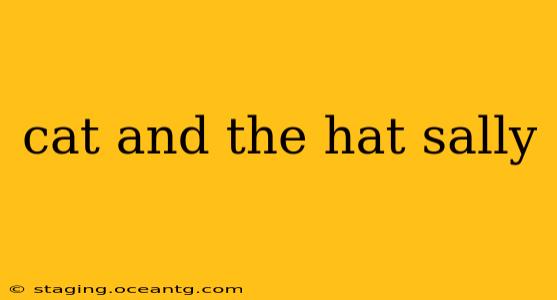Dr. Seuss's The Cat in the Hat is more than just a children's story; it's a cultural phenomenon. Central to its enduring appeal are its memorable characters, particularly the Cat in the Hat himself, and his mischievous sidekicks, Thing 1 and Thing 2. This exploration delves into the personalities and impact of these iconic figures, answering some common questions surrounding their roles in the story and beyond.
Who are Thing 1 and Thing 2?
Thing 1 and Thing 2 are two mischievous, chaotic, and delightfully unpredictable creatures that emerge from the Cat in the Hat's magical red-and-white-striped hat. They are practically embodiments of playful mayhem, wreaking havoc throughout the house with their seemingly endless supply of chaotic energy. While they don't speak in complete sentences, their actions and expressions speak volumes about their nature: pure, unadulterated fun, albeit slightly destructive. They represent the unleashed potential for chaos and the joy of embracing silliness, a counterpoint to the stringent rules and order the children initially experience. Their identical appearance emphasizes their shared chaotic nature, blurring individual identities in a flurry of vibrant activity.
What is Sally's role in The Cat in the Hat?
Sally, along with her brother, is a crucial component of the story's dynamics. While often overshadowed by the Cat in the Hat's larger-than-life presence, Sally is depicted as thoughtful, observant, and slightly more cautious than her brother. She provides a sense of balance to the wild antics unfolding around her, representing the more restrained side of childhood curiosity. While she initially joins in the fun, she also demonstrates concern for the potential consequences of the Cat's visit. This makes her a vital grounding force, anchoring the reader to a degree of realism within the fantastical elements of the narrative. Her character development, though subtle, adds depth to the tale's exploration of childhood imagination and responsibility.
What is the significance of the Cat's hat?
The Cat's iconic red-and-white-striped hat is more than just a fashion statement; it's a symbol of imagination, wonder, and the boundless potential for fun. From the hat emerges the chaos personified by Thing 1 and Thing 2, highlighting the hat's power to conjure and contain extraordinary elements. The hat itself can be viewed as a portal to another reality, a space where the mundane is transformed into the extraordinary, and the rules of reality bend to the Cat's whims. It's a visual representation of the escape into imaginative play, emphasizing the importance of letting loose and embracing the absurd.
How does The Cat in the Hat teach children about responsibility?
Despite the seemingly irresponsible behavior of the Cat, Thing 1, and Thing 2, The Cat in the Hat subtly teaches children about responsibility. The chaos created highlights the importance of respecting rules and boundaries. The story’s climax, where the Cat tidies up before the parents' return, emphasizes the necessity of taking ownership of one’s actions, no matter how wild and carefree they may be. This reinforces the idea that fun and responsibility aren't mutually exclusive; one can enjoy moments of playful chaos, provided they take responsibility for their consequences. This delicate balance forms a core lesson within the seemingly nonsensical narrative.
What is the relationship between the Cat and the children?
The Cat's relationship with the children is complex. He serves as a playful guide into a world of imaginative possibility, defying the monotony of a rainy day. Yet, this guidance is punctuated by a sense of calculated risk; the Cat pushes boundaries, leading the children into situations that are both exciting and slightly concerning. This reflects the dynamic between adult supervision and childhood exploration – a dance between responsible guidance and the unbridled freedom of imagination. The Cat's charm lies in his ability to both enthrall and slightly unsettle, mirroring the experience of navigating the complexities of childhood.
In conclusion, The Cat in the Hat is more than just a whimsical tale; it's a subtle and insightful exploration of childhood, imagination, and responsibility, all brought to life by memorable characters like the Cat in the Hat, Thing 1, Thing 2, and the ever-observant Sally. Their interactions create a narrative that continues to resonate with readers young and old, a testament to Dr. Seuss's masterful storytelling.
